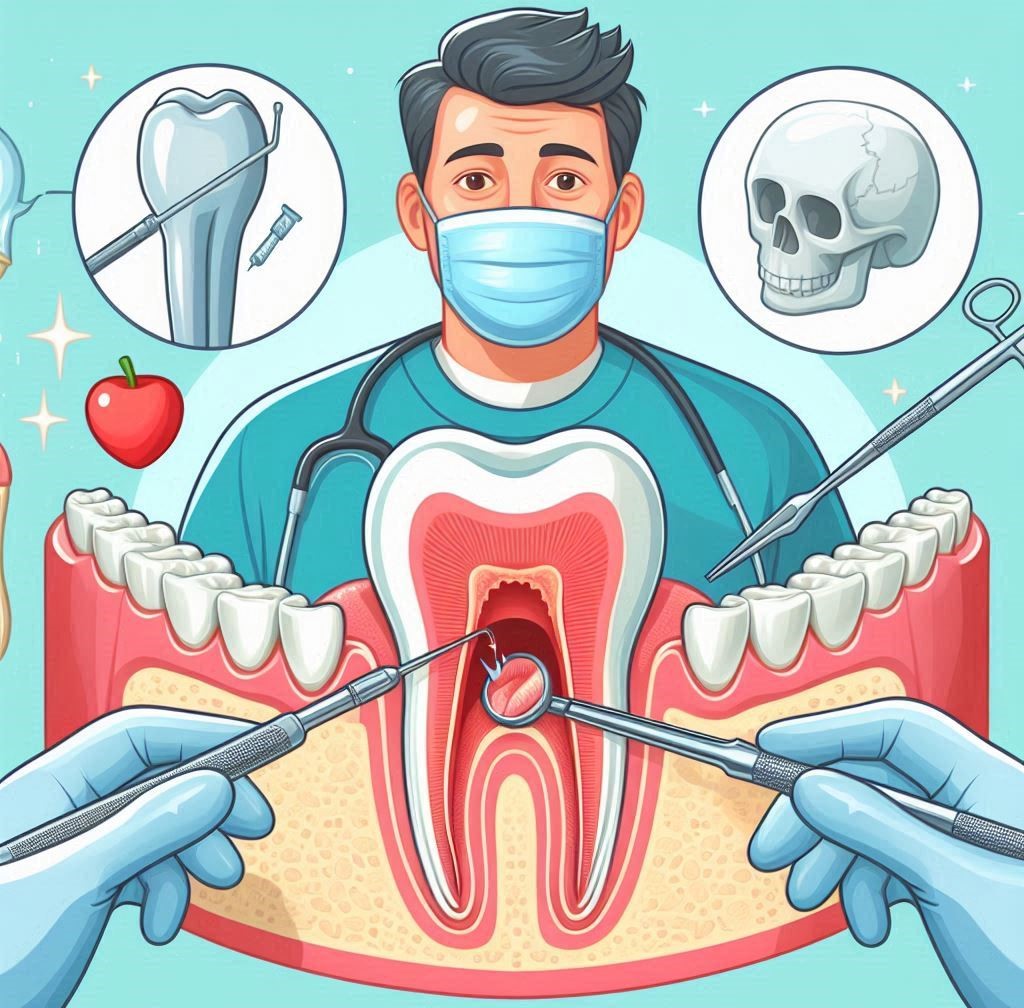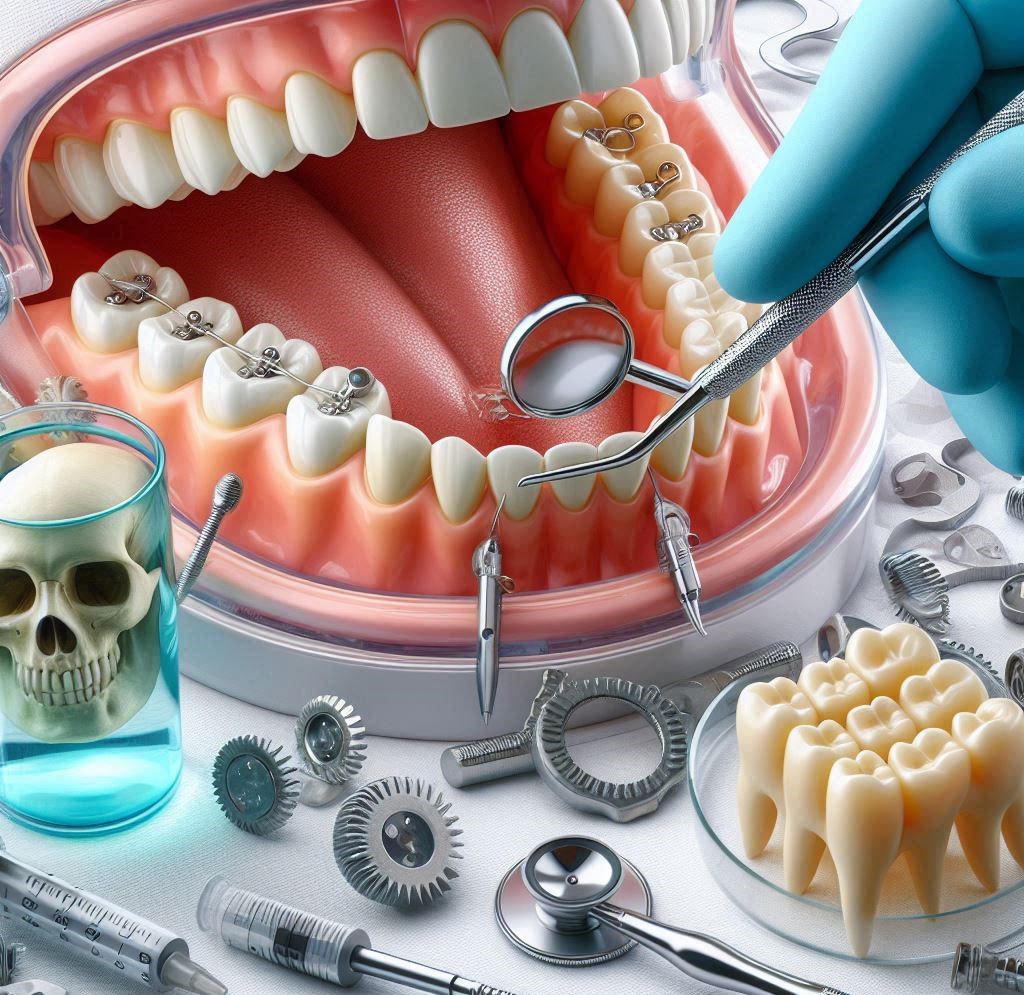Oral surgery, especially for the removal of extra teeth (supernumerary teeth) or abnormal bone growths in the mouth (like exostoses or tori), is often recommended when such issues pose risks to overall oral health. These conditions, though not always problematic, can lead to overcrowding, misalignment of teeth, pain, difficulty chewing, or speech issues. In some cases, they can cause discomfort and lead to further complications, so removal is necessary for both functional and aesthetic purposes.
The idea of surgery can be intimidating, but with the right preparation and understanding, the process can be smooth and recovery can be managed effectively. This guide provides a comprehensive overview of what to expect during the recovery process, including detailed instructions on managing pain, swelling, bleeding, diet, oral hygiene, and emotional well-being.
Understanding the Surgical Procedure: The Basics
What Are Extra Teeth and Bone Growth?
- Supernumerary Teeth: These are extra teeth that develop in addition to the normal set of 32 teeth. They may appear anywhere in the mouth, often in the upper or lower jaw. In many cases, they don’t emerge fully but remain impacted under the gum line. These teeth can disrupt normal alignment and cause crowding, making them an ideal candidate for removal.
- Abnormal Bone Growth (Exostoses and Torus): Bone growths in the mouth are benign (non-cancerous) but can be uncomfortable or problematic. Exostoses are bony projections on the surface of the jawbone, while torus refers to bony growths that often appear along the palate or under the jaw. These growths can interfere with eating, speaking, or wearing dental appliances, making their removal necessary in some cases.
Surgical Methods of Removal
- Simple Extraction: If the extra teeth have emerged through the gum line and are visible, simple extraction may be performed. Local anesthesia will numb the area, and the tooth will be removed.
- Surgical Extraction: For impacted or submerged teeth, an incision is made in the gum tissue, and sometimes part of the bone needs to be removed to access the tooth. This procedure is more invasive and may require stitches afterward.
- Bone Reshaping or Removal: For abnormal bone growths, the surgeon will remove excess bone or reshape the jaw to restore normal function and aesthetics. This can be done through incisions in the gums, and sometimes bone grafting may be needed if significant bone is removed.
Preparation for Surgery: Key Steps Before the Procedure
Proper preparation is essential to ensure the procedure goes smoothly and that your recovery process is as comfortable and complication-free as possible.
Pre-Operative Instructions
Your oral surgeon or dentist will provide detailed instructions before your surgery. These instructions may include:
- Fasting and Hydration: If you are receiving general anesthesia, you will need to refrain from eating or drinking for at least 6-8 hours before surgery to prevent the risk of aspiration. This is a critical safety measure.
- Medications: If you are taking any medications that affect blood clotting (e.g., aspirin, warfarin), your oral surgeon may instruct you to temporarily stop these drugs for a period before surgery. Likewise, if you are on antibiotics or have underlying health conditions like diabetes or heart disease, ensure your surgeon is informed.
- Dental X-Rays and Impressions: Before surgery, you may be asked to take dental X-rays or 3D imaging scans to provide a clear view of the problem area. This ensures that the surgeon can carefully plan the best approach for your surgery.
- Arrange Transportation: If you’re undergoing general anesthesia or sedation, you won’t be able to drive yourself home. Arrange for a trusted friend or family member to take you to and from the procedure.
- Stop Smoking and Alcohol Consumption: Smoking and drinking alcohol can interfere with healing and increase the risk of infection. You should avoid these for at least a week before and after surgery.
What to Expect on the Day of Surgery
On the day of your surgery, you should arrive at your dentist’s or surgeon’s office or surgical center at least 30 minutes before the scheduled time. The surgical team will explain the procedure once more and answer any final questions you have.
You may undergo one of the following:
- Local Anesthesia: In this case, only the area around the affected teeth or bone growth will be numbed. You will be awake during the procedure but won’t feel any pain.
- General Anesthesia: If the surgery is more extensive or if you’re particularly anxious, general anesthesia may be administered, and you’ll be asleep for the procedure.
Understanding Anesthesia
- Local Anesthesia: This is the most common form of anesthesia for minor surgeries. It numbs only the area of surgery, so you’ll be awake but will not feel pain.
- Sedation (Conscious Sedation): Some patients may opt for light sedation, where you are awake but relaxed. This type of anesthesia is commonly used if the procedure is expected to be lengthy or if the patient feels anxious.
- General Anesthesia: For more complex procedures or if the patient prefers to sleep through the surgery, general anesthesia is used. The patient is completely unconscious during the procedure.
Immediate Post-Surgical Care: The Critical First 24-48 Hours
The first 48 hours after surgery are vital to your recovery process. Proper care during this period can significantly reduce the risk of complications and help you recover more quickly.
Rest and Recovery
- Prioritize Rest: Surgery places stress on your body, so it’s essential to rest for the first few days following surgery. Avoid strenuous activities such as exercise or lifting heavy objects. Resting helps your body direct its energy to the healing process.
- Avoid Physical Activity: Any activities that could increase your heart rate or blood pressure, like exercise, can cause bleeding, so it’s important to take it easy.
- Ice Packs: Applying ice to the outside of your face, near the surgical site, will help reduce swelling. Use ice for 20 minutes on, then 20 minutes off, for the first 24–48 hours.
- Keep Your Head Elevated: Swelling is common after surgery, and it often worsens in the first 48 hours. Elevate your head with pillows when lying down to help reduce swelling and prevent further discomfort.
Managing Swelling and Pain
- Cold Compress: Apply ice packs to your face for the first 24-48 hours. The cold helps constrict blood vessels, minimizing swelling and reducing the likelihood of bruising. Use the ice in intervals—20 minutes on, 20 minutes off.
- Swelling: Swelling is a normal part of the healing process and usually peaks within 48 hours, after which it will begin to subside.
- Pain Relief: Your surgeon may prescribe pain medication to help manage discomfort. For mild pain, over-the-counter medications like ibuprofen or acetaminophen may be sufficient. If your pain is more severe, your surgeon may prescribe a stronger medication, such as an opioid painkiller, for a short duration.
- Gauze Pads for Bleeding: Some bleeding right after surgery is normal. Bite gently on a gauze pad to absorb blood and apply pressure. If bleeding persists beyond a few hours or becomes heavy, contact your surgeon immediately.
Bleeding and Signs of Complications
- Normal Bleeding: Expect a small amount of bleeding or oozing from the surgical site during the first few hours after surgery. This should gradually slow down and stop within a day or two.
- Excessive Bleeding: If bleeding is heavy or continues after 24 hours, you may have disturbed a blood clot that is essential for healing. In this case, contact your surgeon right away. A problem like this may lead to dry socket, a painful condition that occurs when the clot is dislodged from the extraction site.
Pain Management: Strategies for a Comfortable Recovery
Managing pain is one of the main concerns after any surgical procedure, and the removal of extra teeth or bone growth is no exception. Understanding your pain management options will help you navigate recovery with minimal discomfort.
Prescription Pain Medications
If the procedure was more complex or if you have a low pain tolerance, your surgeon may prescribe stronger pain medications like hydrocodone, oxycodone, or a combination of narcotics with non-steroidal anti-inflammatory drugs (NSAIDs).
- Opioid Painkillers: These are typically prescribed for short-term use to control moderate to severe pain. They may make you drowsy or constipated, so it’s essential to follow the prescribed dosage and not exceed the recommended amount.
- NSAIDs: Medications like ibuprofen or naproxen help with both pain and inflammation. They are often effective for mild to moderate pain and are less likely to cause dependency.
- Topical Medications: Some patients may benefit from topical medications, such as gels or ointments, which can numb the surgical site and provide local pain relief.
Over-the-Counter Pain Relief
For milder pain or after the first few days, you may find that over-the-counter medications like acetaminophen (Tylenol) or ibuprofen (Advil) are sufficient for pain relief. These drugs work well for managing low-grade pain and reducing swelling.
When to Seek Help for Pain
If you experience any of the following, it’s essential to contact your surgeon or dentist:
- Uncontrolled pain: If pain doesn’t subside or worsens even after taking pain medications.
- Severe pain after the first few days: This could indicate an infection or other complications.
Managing Bleeding and Swelling: Normal vs. Abnormal
Normal Bleeding and Swelling
After surgery, some bleeding and swelling are expected. The bleeding should stop within a few hours after surgery, and swelling will peak around 48 hours before gradually subsiding.
Abnormal Bleeding
Excessive or prolonged bleeding (beyond the first few hours) is not typical. If you notice that the bleeding hasn’t slowed down after several hours or appears to be heavy, apply pressure with clean gauze and call your surgeon immediately.
Techniques to Control Swelling
- Cold Compress: Apply ice packs for 20 minutes at a time during the first 48 hours.
- Warm Compress: After 48 hours, you may switch to warm compresses to help reduce any residual swelling.
Diet and Nutrition After Surgery
What you eat after surgery plays a crucial role in your recovery. A soft, nutrient-rich diet will help speed healing and prevent complications.
The First Few Days: Soft Foods
In the initial 48 hours, your mouth will be sensitive, and chewing may be painful. Stick to soft foods that don’t require much chewing and are easy to swallow:
- Mashed potatoes
- Yogurt
- Applesauce
- Smooth soups (not hot)
- Puddings and custards
- Smoothie bowls
Avoid acidic foods such as citrus, as they can irritate the surgical site. Spicy foods should also be avoided for the first few days to prevent discomfort.
Staying Hydrated
Drinking plenty of fluids is essential for your recovery. Stay hydrated, but avoid using straws. The suction from drinking through a straw can disturb the healing blood clot in the extraction site, potentially causing dry socket.
Foods to Avoid During the Recovery Period
- Hard foods: Crunchy, hard foods like nuts, chips, or raw vegetables can irritate or damage the surgical area.
- Chewy foods: Foods that require a lot of chewing may strain the surgical site and should be avoided until you’re more healed.
- Hot liquids: Wait for a few days before consuming hot beverages like coffee or tea, as the heat may irritate the sensitive area.
Oral Hygiene: Taking Care of Your Mouth
Maintaining oral hygiene is critical to preventing infection. However, you’ll need to adjust your routine in the first few days following surgery.
Brushing and Flossing
For the first 24 hours, avoid brushing the surgical site to prevent disturbing the wound. After the first day, gently brush your teeth with a soft toothbrush but avoid the affected area. You can resume regular brushing and flossing after a week, once the surgical site begins to heal.
Saltwater Rinses
Starting the day after surgery, you can begin rinsing your mouth with a warm saltwater solution (half a teaspoon of salt in 8 oz of warm water). This helps reduce bacteria and soothes the gums. Do this 2–3 times a day, especially after meals.
Special Mouthwashes
Some surgeons recommend antiseptic mouthwashes to help reduce the risk of infection. Choose a mouthwash without alcohol, as alcohol can irritate the healing tissue.
Follow-Up Appointments: Why They Matter
After your surgery, your surgeon will schedule follow-up appointments to monitor your healing progress. During these visits, your surgeon will check for any complications, remove any stitches, and ensure that healing is progressing as expected.
Long-Term Recovery and Full Healing
While the initial recovery period typically lasts a few weeks, full healing—especially of the bone—can take several months. During this period, it’s essential to avoid trauma to the surgical area and follow your surgeon’s advice for long-term care.
Conclusion
Recovering from the removal of extra teeth or abnormal bone growth in the mouth is a gradual process that requires patience, care, and attention to detail. The journey to full recovery begins immediately after the procedure and continues for several weeks. In the first few days, rest is essential to allow your body to heal. Managing swelling, bleeding, and discomfort during this time is critical, and following your oral surgeon’s instructions for pain management and aftercare will help ensure smooth healing. You’ll likely be prescribed pain relief medication to keep discomfort at bay, and using ice packs to reduce swelling can be very effective.
During recovery, maintaining oral hygiene is essential to prevent infection. While you may need to avoid brushing directly on the surgical site initially, rinsing with a saltwater solution can help keep the area clean. Eating soft foods and staying hydrated is also important, but you should avoid hard, crunchy, or spicy foods that could irritate the surgical area.
As you heal, you’ll gradually return to your regular activities, but be sure to follow up with your oral surgeon for check-ups. With proper care and patience, you’ll soon be able to enjoy life without pain or discomfort, free from the issues caused by extra teeth or bone growth.
SOURCES
Amini, A. M., & Brahmbhatt, H. (2021). Complications of oral and maxillofacial surgery: A review of the literature. Journal of Oral and Maxillofacial Surgery, 79(3), 525-533.
Fong, A. L., & Nguyen, P. M. (2020). Post-surgical care in oral surgery: Challenges and strategies. Journal of Dental Research and Reviews, 58(4), 134-142.
Gallo, L. M., & Snyder, K. H. (2019). Understanding supernumerary teeth: Etiology, diagnosis, and management. Journal of Clinical Dentistry, 42(2), 117-124.
Husain, A. J., & Ali, M. H. (2018). Bone growths in the oral cavity: Diagnosis and management of exostoses and tori. Oral Surgery, Oral Medicine, Oral Pathology, Oral Radiology, 126(3), 249-256.
Kumar, P., & Sharma, P. K. (2019). Pain management after oral surgery: A comprehensive review. Journal of Pain Research and Therapy, 31(5), 405-413.
Li, H., & Zhang, X. (2020). Postoperative complications following oral and maxillofacial surgery: Causes and management strategies. Journal of Maxillofacial Surgery, 14(6), 128-133.
Miller, C. S., & Jones, A. J. (2017). Techniques in oral surgery: Current trends in oral surgery for the removal of impacted teeth and bone growths. Journal of Oral Health and Surgery, 51(1), 41-49.
Murray, R. A., & Davis, M. T. (2020). Post-surgical oral care and recovery after tooth extraction: A patient’s guide. Dental Care Journal, 32(7), 88-97.
Prasad, K. V., & Reddy, V. G. (2021). Complications after oral surgery: Management and prevention. Indian Journal of Oral Health and Surgery, 59(2), 78-84.
Singh, G., & Desai, K. A. (2020). A guide to post-operative care after tooth extraction and bone grafting procedures. International Journal of Oral and Maxillofacial Surgery, 49(8), 542-550.
Yadav, A. N., & Kumar, S. (2022). An overview of oral and maxillofacial surgery for supernumerary teeth and exostoses: A comprehensive approach. Journal of Dental Science and Therapy, 45(4), 223-230.
HISTORY
Current Version
March 12, 2025
Written By:
SUMMIYAH MAHMOOD




